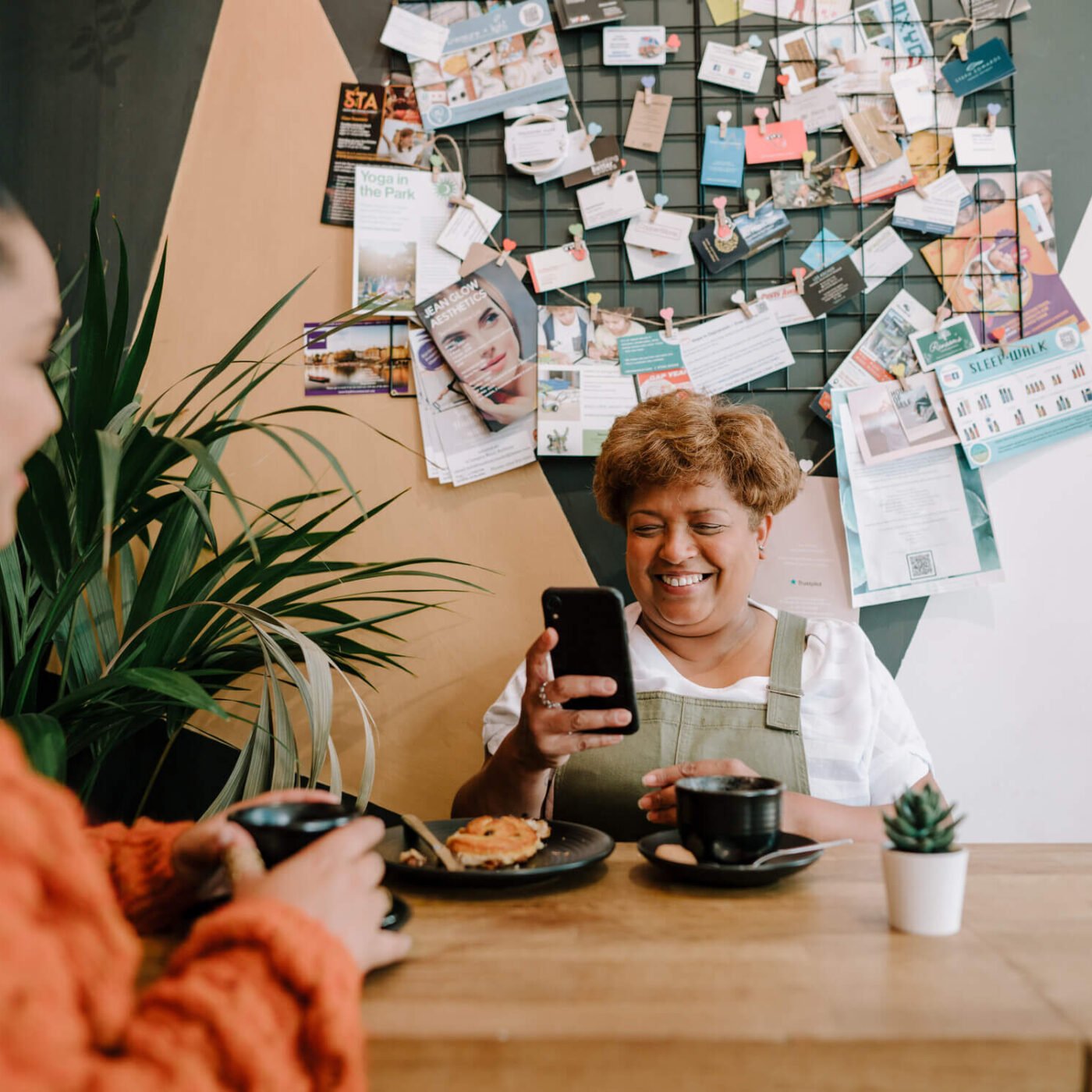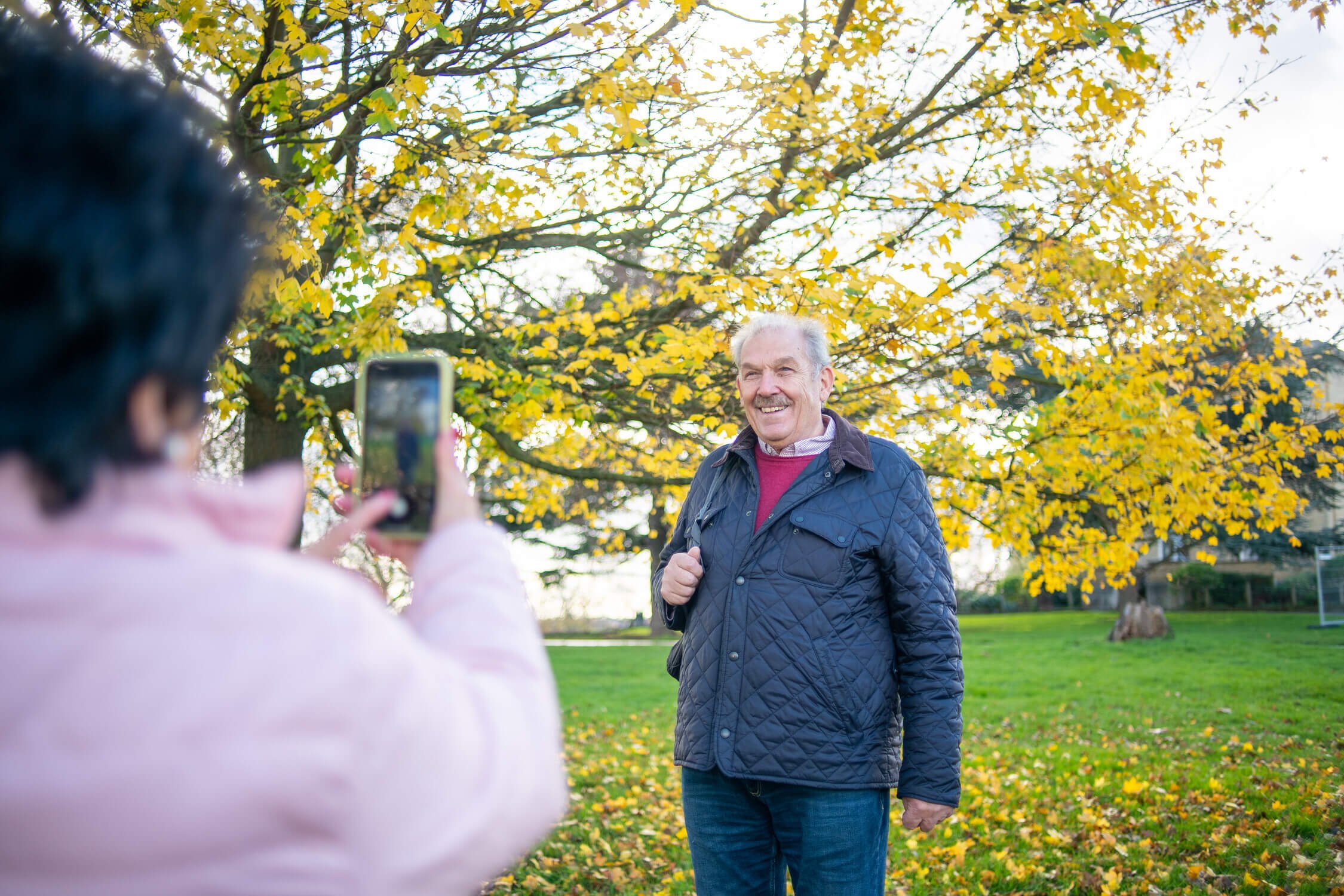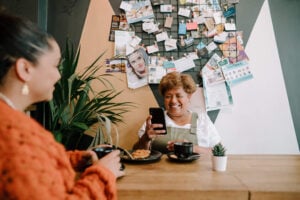How to select the right mobile phone for an elderly family member
Tags
Living Well
Mobile phones are a great way to stay in touch and can provide essential peace of mind to you and your loved ones. However, as people get older they may find it difficult to get to grips with a standard smart phone. In this guide we’ll run through tips on how to choose the right handset for your family member, as well as some popular phone options.
What is the easiest phone for an older person to use?
There’s no one size fits all answer unfortunately – the right phone will be dependent on both your loved one’s ability, and what they want to use it for. For example, people with arthritis or limited physical dexterity will likely want to avoid small fiddly buttons. If someone is living with poor eyesight they may need to opt for a larger screen or voice commands, and if your loved one is experiencing memory loss they may benefit from a phone with a long battery life, so they don’t need to remember to charge it everyday
Tips for making a mobile phone easier to use
If you’ve recently upgraded and have an older handset you’d like to give to a loved one, or if they have a phone already but find it difficult to use, the good news is most mobile phones have in-built accessibility settings that you can adjust. These include –
- Increasing font size
- Setting up voice controls, so that your loved one can search the internet and do lots of functions simply by speaking into the phone
- Using voice to text features to save them from typing messages with the keypad
- Removing unnecessary apps and features, and organising the apps they do need into one simple interface.
Features to look for when buying a mobile phone for an older person
The benefit of buying a mobile phone specifically made with an older person in mind is that they come with a wider range of accessibility and additional safety features. Some features include –
- Extra clear and loud volume
- Hearing aid compatibility
- Larger buttons or well-spaced buttons for easier typing
- Medical information storage
- An emergency button that sends out an emergency alert or GPS location to contacts or specialist services
- charging cradle for easier charging as there’s no fiddly wires or connectors
When choosing a mobile phone it’s important to have a conversation with your loved one to find out what they’d be comfortable with using, and which features would be most important to them. Often people can assume that the older generation would prefer a phone without all the modern bells and whistles, but that’s not always the case. Exploring different functions such as internet browsing, media-streaming services, and video calling might take some practice, but can become a really integral part of keeping up to date with the world, and staying connected with friends and grandchildren.
Understanding mobile networks
There are four different networks in the UK – 5G, 4G, 3G and 2G. The age of a mobile handset can limit what network it can connect to. For example very old phones may be built to connect to 2G – which only allows texting and phone calls. 3G was the first network capable of mobile internet access, but provides very slow connection and download speed compared to 5G and 4G, which is what modern phones use today.
As such 3G networks are expected to be phased out by mobile network providers by 2033. However handsets that use 3G will still be usable for text and voice calls via the remaining 2G network.
What are some popular mobile phones for older people?
Basic phone with buttons
Most modern phones are touch screen, however some older people prefer physical buttons, especially if they struggle with dexterity. Plus, if your loved one only wants a phone for simple calling and texting, a modern smartphone will likely come with a lot of unnecessary features, and take longer to set up and use.
TTFone make a lot of popular large button phones for elderly people which are fairly inexpensive – many handsets can be bought for under £30. Most models come with a large display, talking keys, and and SOS button which initiates a call to a pre-programmed emergency contact or emergency hotline. Many also have picture message capability too, so you and your loved one can share photos
These phones are great for inexperienced phone users, and, because these types of phone aren’t powering a complex touch screen many have an extra-long battery life compared to smart phones.
Straightforward smartphones
If your loved one would like to do some occasional web surfing a touch screen phone with virtual buttons could be a smart choice. The larger screen size will make navigating the internet or using social media apps like Facebook a lot easier, especially if they have poor vision.
The Royal National Institute of Blind People (RNIB) recommend Android powered devices for those with visual impairment, as most have built in accessibility in the form of screen readers that give speech feedback, as well as screen magnification and simple font size settings. There are also a range of Android apps you can download that could make daily life easier – such as apps that identify products when shopping using a barcode reader, and apps that help the user to better navigate the world around them.
RealSam is a smartphone designed specifically for people with limited vision. It’s operated entirely by the users voice – simply tap the screen and talk.
If vision isn’t an issue and you’re looking for a modern smart phone with a stripped-back user interface that’s fairly straightforward to set up, then many consider Motorola Moto handsets to fit the bill. The screens show bright and clear colours, they have good storage so your loved one won’t need to worry about deleting precious photos to free up space, and many models have an in-built ‘tips’ app to help the user get comfortable using their new phone.
If you’re after a smartphone with plenty of battery power then the One Plus Nord CE2 can provide up to 2 days charge in just 30 minutes. It also has a lower price point than many smartphones which can often cost upwards of £500.

Flip phones
Flip phones can be a great in-between phone for those who want physical buttons, but with a larger screen than most standard all-in-one handsets.
because the phone snaps shut when not in use, the screen is protected from knocks and scratches, or accidental dials.
Doro is a company that specialises in phones for older and disabled users, and have a wide range of flip phones – all with large internal screens and high contrast buttons. Some, like the Doro 6880 have an external display too, that shows who’s calling while the phone is closed. Other models like the Doro 2404 have a simple camera for capturing special moments and safety features like an emergency call button feature.
Many Doro phones use a charging cradle, which can be easier to use than long trailing cables.
Mobile phones for people with hearing impairment
A major benefit of carrying a mobile phone is that a loved one is reachable – which can provide peace of mind to friends and family. However, if a loved one is hard of hearing it can be a lot more difficult to respond to calls and messages in a timely manner. Amplified Telephones specialise in mobiles with extra loud volume, clearer sound quality, and accessibility features to improve the user experience for people with hearing issues. These include amplified call volume that’s 8 times louder than standard phones, hearing aid compatibility, and illuminated buttons to notify the user of an incoming call.
They offer a wide range of handsets including phones with buttons, touch screen smartphones, and flip phones.
The simplest phone on the market
If a loved one is experiencing cognitive decline, you may be looking specifically for a phone with very basic features so that they have the means to call you with the touch of a button. The Doro 780X is a really simple phone for elderly users. It features 3 large keys with labels where you can add speed dials to the people they most need to contact. It also has in-built fall protection and an assistance button with GPS.
How much can I expect to pay for a mobile phone for an older loved one?
The phones we’ve mentioned in the article range for £25 to £200 and in many cases you can either pay an up-front device cost for an unlocked handset – leaving you free to purchase a SIM card separately for your desired network provider. This may be a good option if you already have, or wish to set up a family plan, so you can add your loved one’s phone bill to your own.
Alternatively, you may prefer to set your loved one up with their own phone contract. This usually means you won’t need to pay an up-front device cost – instead they’ll pay a set monthly price to cover the cost of the phone and their network usage.
It’s always worth shopping around and comparing phone contracts carefully. Some may seem like a good deal initially, but may also include things that your loved one won’t need – for example, if they prefer to make long phone calls on their landline phone, a mobile package with unlimited calls may not be necessary.
Of course, there’s also pay as you go options. However, these won’t work for everyone as you’ll want to feel confident that your loved one will remember to top up, or let you know when they’re out of credit so that you can top up their credit for them.
Sources –
- https://www.ttfone.com/collections/big-button-mobiles
- https://www.rnib.org.uk/living-with-sight-loss/assistive-aids-and-technology/phones-and-tablets/android-phones-and-tablets/
- https://realsam.co.uk/realsamphone/
- https://www.expertreviews.com/uk/mobile-phones/1409584/best-simple-mobile-phone-for-older-people-senior-pensioner
- https://www.amplifiedtelephones.co.uk/mobile-telephones.html
- https://www.ageco.co.uk/useful-articles/money/the-best-mobile-phones-for-the-elderly/
- https://www.rnib.org.uk/living-with-sight-loss/assistive-aids-and-technology/navigation-and-communication/helpful-apps/
Read more from Elder

12 summer safety tips for the elderly
It’s important for everyone to take care in hot weather – anyone can become unwell if they’re exposed to soaring temperatures. However, for older people

How to select the right mobile phone for an elderly family member
Mobile phones are a great way to stay in touch and can provide essential peace of mind to you and your loved ones. However, as

Christmas gift ideas for elderly parents who have everything 2024
Looking for the perfect gift for an older person in your life? From gifts that can help make their daily lives easier, to those with

Elder fraud and scams – staying safe in later life
Fraud can happen to anyone, but sadly vulnerable people and those over pension age are regularly targeted. A report by Age UK indicates that almost

Winter foot care tips
Taking care of your feet in later life is really important. Foot problems can cause pain and discomfort, this can impact your balance which can

16 Halloween safety tips for older people
16 Halloween safety tips for older people Written by Zenya Smith • 01/10/24 Looking for a carer? Halloween can be a magical time for many,